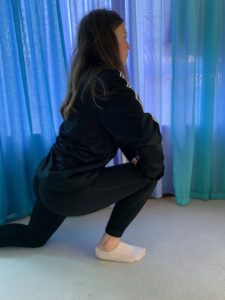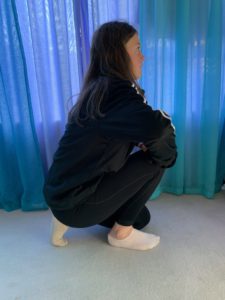Plantar fasciitis is a pretty common ailment amongst runners, walkers and even unfortunately dancers. In this post, I will look at how to cure Plantar Fasciitis with the use of some great stretches that are important for the flexibility and range of motion of the lower leg, ankle and foot muscles.
Good flexibility around the ankle and foot allows for unrestricted, pain-free movement of the ankle, foot and arch, so it makes sense to stretch out these muscles on a regular basis whether or not you have Plantar Fasciitis.
What Is Plantar Fasciitis?
Plantar fasciitis (PLAN-tur fas-e-I-tis) is one of the most common causes of heel pain. It involves inflammation of a thick band of tissue that runs across the bottom of your foot and connects your heel bone to your toes (plantar fascia). The plantar fascia acts as your shock absorber, but if it becomes inflamed it can be very painful.
It is most commonly caused by strain injury causing micro-tears to the ligament as it attaches to the heel bone or other areas of tightness on the sole of the foot.
How To Cure Plantar Fasciitis
Here are some quick relief tips that may help you if you find that the pain is too much to cope with.
Wear Supportive Footwear
Wear shoes that provide good arch support and have a low heal, especially if you’re going to be on your feet a lot. This helps to support your plantar fascia and prevent them from becoming inflamed or more inflamed.
Your doctor may recommend orthotic shoe inserts or foot pads to help distribute your weight more evenly, especially if you have high arches or flat feet.
You can get them ready-made at most pharmacies, or your doctor can have some made custom for your feet. The shoes below either has built-in orthotics or you can put the orthotic that your doctor gives you into the shoe.
Click on the links or on the pictures if you want to find out more about the products mentioned.
ASICS Women’s Gel-Venture 5 Running Shoe, Silver Grey/Turquoise/Lime Punch, 9 M US


 These Asics are 100% synthetic, have a rubber sole, arch support and a gel cushioning system.
These Asics are 100% synthetic, have a rubber sole, arch support and a gel cushioning system.You can remove the sock liner and put more supportive orthotics inside if need be.
Vionic Women’s Agile Kea Slip-on Black Black 7.5M US

 These comfy shoes are great orthotic trainers. They are firm for support, yet flexible and there is a removable textile-covered EVA orthotic insert inside.
These comfy shoes are great orthotic trainers. They are firm for support, yet flexible and there is a removable textile-covered EVA orthotic insert inside.

 These sandals are beyond comfortable. They have a built-in orthotic which has been shown to be effective in helping to treat pain that is associated with plantar fasciitis.
These sandals are beyond comfortable. They have a built-in orthotic which has been shown to be effective in helping to treat pain that is associated with plantar fasciitis.It also helps with a mild to moderate pronation of the foot, metatarsal pain, heel and arch discomfort, flat feet, sore feet and other common foot ailments.
The sandals are lightweight, flexible and have controlled cushioning that reduces stress on the heels, feet and knees.
Essential Oils
Applying Lavender essential oil may help as it has anti-inflammatory properties that make it a possible treatment for pain caused by inflammation.

 Try diluting a drop or two in a carrier oil, such as olive or coconut oil, and massaging it into the bottoms of your feet. You can also try adding a few drops to a warm foot bath.
Try diluting a drop or two in a carrier oil, such as olive or coconut oil, and massaging it into the bottoms of your feet. You can also try adding a few drops to a warm foot bath.If you regularly wear the same shoes to exercise, make sure to replace them from time to time. Signs that you need a new pair include:
- wear on the outsoles
- stretching of the heels
- moulding of the insoles to the shape of your foot
- breakdown of shoe interior
- new blisters forming on your feet
- new pain in your feet, legs, or back
Runners should replace their athletic shoes every 400–500 miles. Nonrunners should replace athletic shoes every six months or so, depending on how often you wear them.
Massage
You can perform simple massage techniques to soothe the pain in your heels. Use your thumbs to massage your arches and heels, working from the balls of your feet up to your heel. You can also use a golf ball to massage your arches. Put your foot on the golf ball, hang on to a stable item, and roll the golf ball under your arches.
Use Ice On The Affected Area
An ice pack like the one pictured here that can be purchased online can help to reduce inflammation.

 Cover your ice pack if you need to with a cloth or thin towel and hold it over the painful area three to four times daily for 15 to 20 minutes at a time.
Cover your ice pack if you need to with a cloth or thin towel and hold it over the painful area three to four times daily for 15 to 20 minutes at a time.Use A Tennis Ball
Gently massage your foot by rolling it on a tennis ball. Concentrate on the areas that are sensitive.
Lose Some Weight
Carrying extra weight puts more pressure on your plantar fascia. If you’re overweight, losing a few pounds can help to alleviate some of that pressure.
Rest
Sometimes, plantar fasciitis is a sign that your feet simply need to rest, especially if you regularly do high-impact sports. Giving your feet a break for a few days can help to reduce inflammation and let your plantar fascia heal. While you heal, try a low-impact activity like swimming.
Plantar Fasciitis Stretches
Running, Sprinting, Track, Cross Country, Walking, Dancing, gymnastics and any sport that involves jumping or explosive movement will benefit by using plantar fasciitis stretches regularly.
While performing the plantar fasciitis stretches below there are a number of muscles within the lower leg and arch of the foot that are stretched.
Below is a comprehensive list of the anatomical muscle names involved in the following plantar fasciitis stretches.
- Tibialis posterior (Upper calf);
- Soleus (Lower calf and Achilles);
- Flexor hallucis longus, Flexor digitorum longus, Peroneus longus and brevis (Lower calf);
- Flexor digitorum brevis, Abductor hallucis, Abductor digiti minimi, Quadratus plantae (Arch of the foot); and
- Flexor hallucis brevis, Adductor hallucis, Flexor digiti minimi brevis (Arch of the foot);
As with any activity, there are rules and guidelines to ensure that they are safe and stretching is no exception.
Stretching can be harmful and cause injury if done incorrectly, so make sure that you follow these guidelines below:
- Warm-up the muscles you want to stretch before you begin.
- Don’t hold your breath because holding your breath can cause tension in your body and in your muscles. Breathe deeply and relax while performing your stretches.
- Never force a stretch beyond the point of mild tension. Stretching tight muscles, and especially the muscles in the arch of the foot, can be uncomfortable, but you should never feel acute pain. Move into the stretch until you can feel mild tension and if you do feel any pain, stop immediately.
- It’s obviously difficult to stretch if your clothes are too tight, so make sure that they are loose, comfortable and don’t restrict your movement.
- Be consistent because stretching for a few minutes each day will gradually build flexibility and range of motion. This is far preferable to stretching only once a week for a longer time.
Plantar Fasciitis Stretch Number 1
Kneel with one leg at the back and one leg in the front. Bring your front foot in underneath you and push gently on the knee, taking your body forward. Make sure your foot is still flat on the floor. You will feel your ankle and back of heel stretching, and possibly also feel pressure on the front of the ankle.

Hold this stretch for 20 to 30 seconds while relaxing and breathing deeply. Repeat on the other side then repeat 2 or 3 times.
Plantar Fasciitis Stretch Number 2
Kneel on one foot with your hands on the ground. Place your body weight over your knee and slowly move your knee forward.

Keep your toes on the ground and arch your foot. Hold this stretch for about 20 to 30 seconds and repeat at least 2 to 3 times on each side.
Plantar Fasciitis Stretch Number 3
Plantar Fasciitis Stretch Number 4 and 5
Want more Plantar Fasciitis Stretches?
This book can be purchased on Amazon and is one of their best sellers, so you know the advice works.
The 5-Minute Plantar Fasciitis Solution



Jim Johnson, P.T. is a physical therapist who has spent over 28 years treating both inpatients and outpatients with a wide range of pain and mobility problems – from back pain to heart transplants to neuromuscular disorders.
He has written many bestselling pain books – all based completely on published research and controlled trials. His books have been translated into other languages, and thousands of copies have been sold worldwide.
Besides working full-time as a clinician in a major teaching hospital and writing books, Jim Johnson is a certified Clinical Instructor by the American Physical Therapy Association and enjoys teaching physical therapy students from all over the United States.
And if you want to take your flexibility to the next level try these advanced stretching techniques.
 Learn how to stretch properly and get a deeper, more targeted stretch, which is guaranteed to…
Learn how to stretch properly and get a deeper, more targeted stretch, which is guaranteed to…
- Get rid of injuries, aches and pains with ease;
- Improve your freedom of movement and mobility;
- Do away with stiff, tight muscles and joints;
- Improve your sporting performance; and
- Take your flexibility to a whole new level.
More than 70,000 people just like you have used my Ultimate Guide to Stretching & Flexibility to turn muscles made of rock into loose, limber, supple muscles that move with pain-free ease!
Claim your copy of my Ultimate Guide to Stretching & Flexibility and discover how to get loose, limber and pain-free in less than 10 minutes a day.
I trust that this post has helped you in your quest of how to cure plantar fasciitis. if you have any comments or anything to add, please fill in the form below this post.

